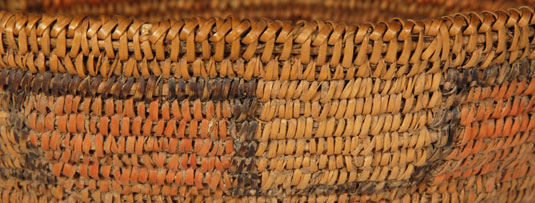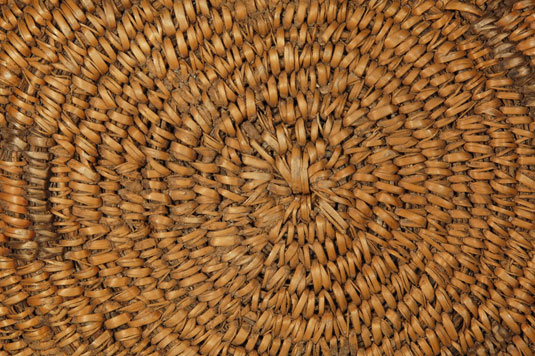Very Old Navajo Deep Basket Bowl [SOLD]
+ Add to my watchlist Forward to Friend
- Category: Bowls and Other Forms
- Origin: Diné of the Navajo Nation
- Medium: sumac rods, yucca fibers
- Size: 4” deep x 11-5/8” diameter
- Item # C3776ZA SOLD

Navajo women made many baskets before they were rounded up by Kit Carson and forced to walk to Bosque Redondo in southern New Mexico where they were imprisoned for over four years. After their release and return to their homestead, baskets became important because natural materials for construction were free. They needed baskets for gathering seeds and roots, cooking, carrying burdens, parching and winnowing and for other domestic and ritual purposes.
After the return to their homelands, basket making continued as a necessity until around 1880, the time trading posts appeared on the Navajo reservation, and it became convenient to trade for or purchase commercial containers for daily use. Another factor that contributed to the decline of basket making among the Navajo was the ritual taboos forced on the women. “They were forbidden to have intercourse, no one was allowed to touch them, and their sumac materials had to be placed so nobody would step over them. The women were kept in isolation to observe dietary restrictions, they could not work while menstruating, and they had to undergo ceremonial cleansing before and after the making of a basket.” Whiteford1988
Because of the influence of traders, baskets never became a commercial product for tourists. Traders urged the women to make rugs as they were more profitable and more saleable than baskets. This, too, contributed to the loss of basket making among the Navajo. To compensate for this loss of basket making among the Navajo baskets were made by the San Juan Paiutes and Utes for the Navajo.
Small food-gathering baskets such as this one were made with sumac over rods and traditionally had a herringbone weave at the rim. The only colors in traditional baskets are black and deep russet red. “Weavers made black in several ways, resulting in a range of colors from dark gray to jet. Powdered surface coal or slightly roasted ochre (hydrated iron oxide) was boiled with sumac leaves and piñon pitch, and the sewing splints were steeped in this solution until they absorbed the color. To dye splints red, the pot was filled with a mixture of juniper roots and the crushed bark of mountain mahogany root with a touch of alder bark and the ashes of burnt juniper or cedar needles. Whiteford1988
This basket could be as early as the late 1800s or early 1900s.
Condition: very good condition
Reference: Southwestern Indian Baskets—Their History and Their Makers by Andrew Hunter Whiteford
Provenance: from the collection of a gentleman from Colorado

- Category: Bowls and Other Forms
- Origin: Diné of the Navajo Nation
- Medium: sumac rods, yucca fibers
- Size: 4” deep x 11-5/8” diameter
- Item # C3776ZA SOLD



